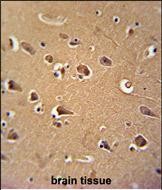CALM1 Antibody (C-term)
Affinity Purified Rabbit Polyclonal Antibody (Pab)
- 产品详情
- 实验流程
- 背景知识
Application
| WB, FC, IHC-P, IF, E |
|---|---|
| Primary Accession | P0DP23 |
| Other Accession | P05419, P62155, P62161, P62160, P62204, P62152, Q6PI52, P62149, O16305, P62157, NP_008819 |
| Reactivity | Human |
| Predicted | Mouse, Rat, Rabbit, Zebrafish, Chicken, Xenopus, Bovine, C.Elegans, Drosophila |
| Host | Rabbit |
| Clonality | Polyclonal |
| Isotype | Rabbit IgG |
| Calculated MW | 16838 Da |
| Antigen Region | 107-132 aa |
| Gene ID | 801;805;808 |
|---|---|
| Other Names | Calmodulin, CaM, CALM1, CALM, CAM, CAM1 |
| Target/Specificity | This CALM1 antibody is generated from rabbits immunized with a KLH conjugated synthetic peptide between 107-132 amino acids from the C-terminal region of human CALM1. |
| Dilution | WB~~1:1000 FC~~1:10~50 IHC-P~~1:100~500 IF~~1:10~50 E~~Use at an assay dependent concentration. |
| Format | Purified polyclonal antibody supplied in PBS with 0.05% (V/V) Proclin 300. This antibody is prepared by Saturated Ammonium Sulfate (SAS) precipitation followed by dialysis against PBS. |
| Storage | Maintain refrigerated at 2-8°C for up to 2 weeks. For long term storage store at -20°C in small aliquots to prevent freeze-thaw cycles. |
| Precautions | CALM1 Antibody (C-term) is for research use only and not for use in diagnostic or therapeutic procedures. |
| Name | CALM1 {ECO:0000303|PubMed:7925473, ECO:0000312|HGNC:HGNC:1442} |
|---|---|
| Function | Calmodulin acts as part of a calcium signal transduction pathway by mediating the control of a large number of enzymes, ion channels, aquaporins and other proteins through calcium-binding (PubMed:16760425, PubMed:23893133, PubMed:26969752, PubMed:27165696, PubMed:28890335, PubMed:31454269, PubMed:35568036). Calcium-binding is required for the activation of calmodulin (PubMed:16760425, PubMed:23893133, PubMed:26969752, PubMed:27165696, PubMed:28890335, PubMed:31454269, PubMed:35568036). Among the enzymes to be stimulated by the calmodulin-calcium complex are a number of protein kinases, such as myosin light-chain kinases and calmodulin-dependent protein kinase type II (CaMK2), and phosphatases (PubMed:16760425, PubMed:23893133, PubMed:26969752, PubMed:27165696, PubMed:28890335, PubMed:31454269, PubMed:35568036). Together with CCP110 and centrin, is involved in a genetic pathway that regulates the centrosome cycle and progression through cytokinesis (PubMed:16760425). Is a regulator of voltage- dependent L-type calcium channels (PubMed:31454269). Mediates calcium- dependent inactivation of CACNA1C (PubMed:26969752). Positively regulates calcium-activated potassium channel activity of KCNN2 (PubMed:27165696). Forms a potassium channel complex with KCNQ1 and regulates electrophysiological activity of the channel via calcium- binding (PubMed:25441029). Acts as a sensor to modulate the endoplasmic reticulum contacts with other organelles mediated by VMP1:ATP2A2 (PubMed:28890335). |
| Cellular Location | Cytoplasm, cytoskeleton, spindle. Cytoplasm, cytoskeleton, spindle pole. Cytoplasm, cytoskeleton, microtubule organizing center, centrosome. Cell projection, cilium, flagellum {ECO:0000250|UniProtKB:P0DP26} Note=Distributed throughout the cell during interphase, but during mitosis becomes dramatically localized to the spindle poles and the spindle microtubules |
For Research Use Only. Not For Use In Diagnostic Procedures.
Provided below are standard protocols that you may find useful for product applications.
BACKGROUND
CALM1 is a member of the EF-hand calcium-binding protein family.Calmodulin mediates the control of a large number of enzymes and other proteins by Ca(2+). Among the enzymes to be stimulated by the calmodulin-Ca(2+) complex are a number of protein kinases and phosphatases. Together with CEP110 and centrin, is involved in a genetic pathway that regulates the centrosome cycle and progression through cytokinesis.
REFERENCES
Zhao,D., et.al., Zhonghua Yi Xue Za Zhi 88 (35), 2452-2456 (2008)
Martins-de-Souza,D., et.al., J. Neural Transm. 116 (3), 275-289 (2009)
终于等到您。ABCEPTA(百远生物)抗体产品。
点击下方“我要评价 ”按钮提交您的反馈信息,您的反馈和评价是我们最宝贵的财富之一,
我们将在1-3个工作日内处理您的反馈信息。
如有疑问,联系:0512-88856768 tech-china@abcepta.com.























 癌症的基本特征包括细胞增殖、血管生成、迁移、凋亡逃避机制和细胞永生等。找到癌症发生过程中这些通路的关键标记物和对应的抗体用于检测至关重要。
癌症的基本特征包括细胞增殖、血管生成、迁移、凋亡逃避机制和细胞永生等。找到癌症发生过程中这些通路的关键标记物和对应的抗体用于检测至关重要。 为您推荐一个泛素化位点预测神器——泛素化分析工具,可以为您的蛋白的泛素化位点作出预测和评分。
为您推荐一个泛素化位点预测神器——泛素化分析工具,可以为您的蛋白的泛素化位点作出预测和评分。 细胞自噬受体图形绘图工具为你的蛋白的细胞受体结合位点作出预测和评分,识别结合到自噬通路中的蛋白是非常重要的,便于让我们理解自噬在正常生理、病理过程中的作用,如发育、细胞分化、神经退化性疾病、压力条件下、感染和癌症。
细胞自噬受体图形绘图工具为你的蛋白的细胞受体结合位点作出预测和评分,识别结合到自噬通路中的蛋白是非常重要的,便于让我们理解自噬在正常生理、病理过程中的作用,如发育、细胞分化、神经退化性疾病、压力条件下、感染和癌症。









